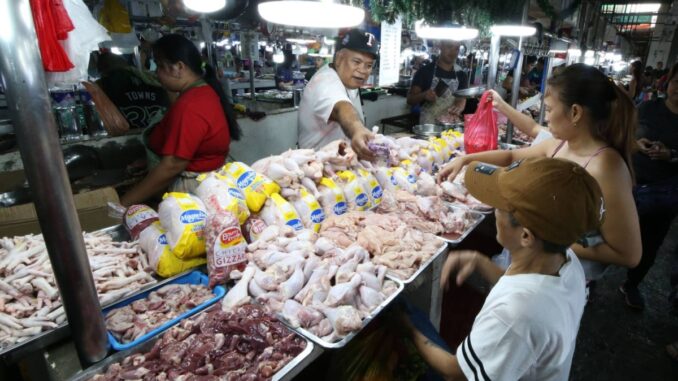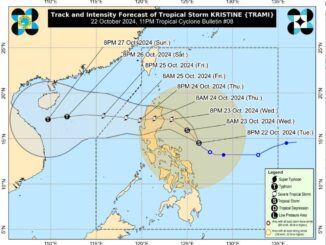
(UPDATES) INFLATION slowed to 1.9 percent in September from 3.3 percent in August, the Philippine Statistics Authority (PSA) reported on Friday.
Year-on-year inflation was at 6.1 percent, the PSA said.
It was the lowest inflation rate since the 1.6 percent in May 2020 and brings the national average inflation from January to September to 3.4 percent and the average core inflation to around 2.4 percent.
The 1.9 percent was close to the Bangko Sentral ng Pilipinas’ (BSP) forecast of 2 to 2.8 percent, and far from the analysts’ projections of 2.6 percent.
The PSA attributed the downtrend in overall inflation in September to the slower annual increment in the indices of food and non-alcoholic beverages, transport and household commodities.
“Food and non-alcoholic beverages inflation was at 1.4 percent in September 2024, a decline from 3.9 percent in the previous month, brought about by the slowdown of increase in prices in both cereals and cereal products, and in vegetables,” PSA Undersecretary Claire Dennis Mapa said.
“Meanwhile, transport inflation was recorded at -2.4 percent during the month of September, a big difference from -0.20 percent recorded in August 2024, because of the faster lowering of prices in gasoline and diesel. Lastly, a slower inflation rate was recorded for housing, water, electricity, gas, and other fuels during the month, which was at 3.2 percent in September from 3.8 percent in August 2024, because of a slowdown in the increase in prices of liquefied petroleum gas and a slowdown increase in electricity prices,” Mapa said.
The PSA said food inflation at the national level eased to 1.4 percent in September from 4.2 percent in the previous month, primarily because of the slower inflation rate of rice.
Following the national trend, the inflation rate in the National Capital Region (NCR) shrank to 1.7 percent from 2.3 percent in August.
The rate in areas outside NCR also decelerated to 2 percent in September from 3.6 percent in August.
For the Bank of the Philippine Islands (BPI), the slowdown in inflation was due to improving weather conditions, food and oil global developments, and recent government policies.
“This improvement comes as El Niño has ended, and global rice prices have declined following India’s lifting of its rice export ban. Additionally, the government’s efforts to expedite the distribution of imported rice from ports to markets have further stabilized supply,” the BPI said.
“In addition, the contribution of housing and utilities to inflation has remained steady over the past month, still reflecting the deferral of June’s electricity charges. Stable oil and commodity prices have also kept electricity costs under control, with the economic slowdown in China reducing demand for oil,” it added.
The bank warned, however, that there are various risks still on the horizon, such as La Niña, which could disrupt vegetable production, and the escalation of conflict in the Middle East.
The BSP said inflation could speed up again, fuelled by the impact of the lower import tariffs on rice, and worsening geopolitical risks in the Middle East and Ukraine.
The National Economic and Development Authority (NEDA) said the slowing inflation will help boost consumer confidence and, in turn, drive higher spending and consumption and fuel business expansions.
“Additionally, easing food prices will relieve low-income households, enabling them to allocate more to other essential needs such as education and health. We will sustain the momentum as we assure the public that we will continue to pursue and carry out strategies to maintain stable prices of food and other commodities,” NEDA Secretary Arsenio Balisacan said.
Speaker Martin Romualdez said the drop in the inflation rate meant that the intervention measures taken by the government are now yielding positive results.
Romualdez said the cutting of the rice import tariff from 35 percent to 15 percent and the direct sale of rice through the Kadiwa stores “have significantly reduced the retail price of rice, from above P50-P60 per kilo to P40-P42 per kilo, or by at least 20 percent.”
House Ways and Means Committee chairman Jose Maria Clemente Salceda said the “surprisingly low” inflation figures give the Marcos administration plenty of room to pursue more ambitious spending programs in economic and social services.
“It also gives the Bangko Sentral ng Pilipinas much room for maneuver when the US Fed and other central banks inevitably adjust their interest rate levels,” Salceda added.
Salceda said that the massive disinflation in fruits and vegetables, and the slight reduction of prices for fish were the main causes of low food inflation.
House Appropriations Committee chairman Elizaldy Co praised the Marcos administration for its efforts in reducing inflation.
Co said the administration’s whole-of-government approach, including cutting tariffs on imported rice, has stabilized prices and made goods more affordable for Filipinos.
“We must prioritize strengthening food security by supporting our farmers. Congress is prepared to pass necessary legislation and allocate needed funds to help our agricultural sector thrive,” he said.
WITH RED MENDOZA





Be the first to comment